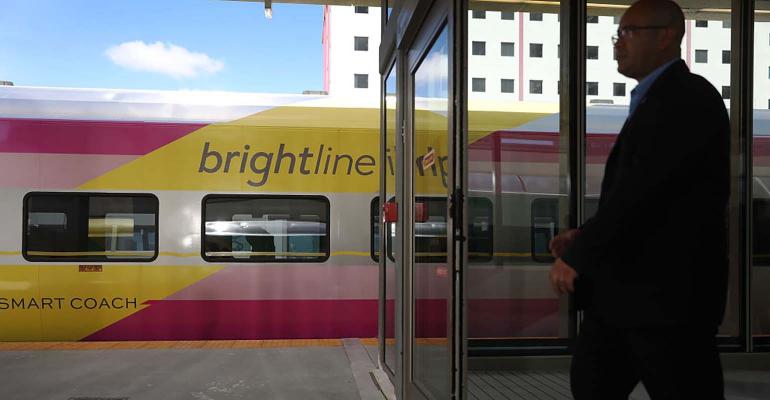(Bloomberg) -- New York has Metro-North, London has the Network Southeast. Miami has the Brightline — and these days, people are climbing aboard.
Ridership on the five-year-old rail line, which connects Miami and West Palm Beach, has taken off as wealth has poured into South Florida, boosting the bonds that funded it by as much as about 20% this year. The number of passengers was up nearly 80% through June.
The high-speed line is one more reflection in the kaleidoscopic story of the new wealth pouring into Miami. Even the municipal bonds used to finance the privately owned railway have appreciated in value recently, much like South Florida real estate, private school fees and seemingly everything else in the Miami area. The soon to be 235-mile-long private rail is owned by the same company that hopes to link Los Angeles and Las Vegas by train.
But with mass transit systems elsewhere still coping with the financial strains of the pandemic, the Fortress Investment Group-backed Brightline and its bonds provide one more small piece of evidence that, for now, Miami is hot in more ways than one.
The momentum from an upcoming extension to Orlando — in combination with the relative cheapness of the securities — have caused the bonds to far out pace a 5.5% gain for high-yield municipal bonds, according to Bloomberg’s index data.
Some of the recent ridership growth is attributable to a more than two-fold increase in commuter and corporate passes as the region booms with business relocations and major cultural events.
Citadel relocated its headquarters to Miami from Chicago and Elliott Investment Management switched from Manhattan to West Palm Beach. And Brightline was filled with soccer fanatics heading to Lionel Messi’s debut last Friday.
“I think a lot of the retail investors actually live down in South Florida and they’ve witnessed and seen all the activity with Brightline and around the Brightline stations,” said Ryan Rosberg, a Nuveen LLC senior research analyst. “They want to be part of the action.”
While it’s still unclear whether enough Florida residents and tourists will give up their cars, bondholders have taken some comfort in Fortress’s support. After Brightline issued debt in 2022, Fortress contributed $443 million in equity, bringing its investment to $2.1 billion.
So far this year, about $34.5 million Brightline bonds in blocks of at most $100,000 have traded, compared with $3.5 million and $22.6 million respectively, during the same periods in 2022 and 2021, according to data compiled by Bloomberg. That indicates an interest in retail purchases.
Even though the bonds are generally bought by institutional buyers, they can be transfered to accredited investors with an annual income of at least $200,000 and a net-worth of over $1 million. Rosberg said such debt is typically bought by high-net-worth retail investors through “various wealth channels.”
Nuveen is the biggest municipal bond investor in the project, holding about $2.7 billion of the securities, or 73% of the project’s outstanding bond debt, according to data compiled by Bloomberg.
Perhaps even more important for performance was investors’ view that the debt was simply too cheap to pass up.
In January, Brightline’s most actively traded debt, unrated securities with a 7.375% coupon, traded at 88 cents on the dollar to yield 8.6%, close to the highest yield since the bonds were issued in 2019. On Wednesday, the bonds traded at 101.5 cents on the dollar to yield 7.1%.
“Starting at that level, it’s hard to find anything else that comes close to that type of yield unless you’re in some type of major default or distress,” said Chad Farrington, a portfolio manager at DWS Investment Management. “I don’t think fundamentals are the main driver. I think the main driver is just the fact it started out cheap.”
Orlando Extension
Brightline has yet to be profitable, losing $260 million last year. One-way tickets for the 3 hour and 30 minute trip from Miami to Orlando cost $79 for regular seats and $149 for premium, according to Brightline’s website. The trains are expected to reach maximum speeds of 125 miles-per-hour.
The company plans to open the 168-mile extension to Orlando International Airport as soon as Sept. 1, ideally capturing the flood of tourists vacationing to Walt Disney World Resort. In April, Brightline invited more than 300 guests to its new 37,500 square-foot station at the airport, where politicians and executives were joined by muni-bond dealers and institutional investors.
After opening the Orlando extension, Brightline plans to extend the line west to Tampa, with a projected completion in 2028.
It’s also negotiating commuter rail initiatives with Miami-Dade and Broward counties to lease its corridor for commuter service and act as a feeder to its intercity service. Miami-Dade has agreed to make $50 million in upfront payments to Brightline and annual access payments for 30 years starting at $12 million annually.
Given the dearth of junk muni issuance this year, the Brightline bonds could rally even further if high-yield muni fund inflows pick up, Farrington said.
Brightline said in June that it’s planning a series of potential refinancings for its outstanding bonds, which could include new issuances of debt or equity and a public rating.




